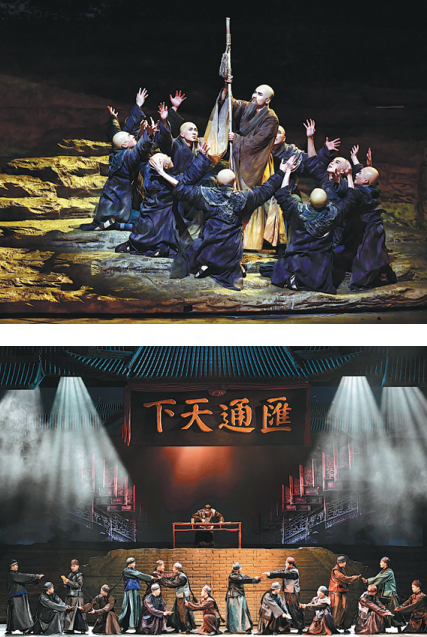Uniting stories of Silk Road through dance





With expressive poetic moves and a multimedia stage design, dance drama The Great Unity tells stories of the Silk Road and encapsulates thousands of years of history and culture of Shanxi province.
In celebration of the 100th anniversary of the founding of the Communist Party of China, two performances of The Great Unity were held at the National Center for the Performing Arts on May 22 and 23.
The dance drama comprises nine scenes, each featuring a historic period or cultural heritage. From the mythological goddess Leizu who invented sericulture to the modern-day Belt and Road Initiative, the wish of all human beings joining hands in unity and harmony is expressed in the drama.
Li Jianbo, director of The Great Unity, says the title of the production is a common motif that can be drawn from all these historical episodes.
"Presenting history from different periods is a tricky task because they need to be cohesively connected. So in the production, we came up with this idea of taking a modern-day perspective and traveling through time," Li says.
"I found from my research that throughout the time periods, Chinese civilization pursues great unity of the people and harmony of the world. In the past, this idea was reflected from our diplomatic relations with other countries and amalgamation among different ethnic groups, and today's BRI aims for the same goal."
To illustrate the history of the Silk Road, the dance draws inspiration from Shanxi's historical heritage and figures, including the awe-inspiring Yungang Grottoes in Datong, the monk Faxian who traveled to more than 30 countries collecting Buddhist scriptures, and Shanxi merchants who promoted transnational trade and cultural exchange in the 19th century.
Li says the production is a combination of dance drama and poetry. Instead of dealing with a linear storyline, the audience is presented with varied scenes or events from different times and spaces, and these scenes are connected like verses of a poem.
The production's grand narrative is performed by a cast from around the country.
Experts and performers from the Song and Dance Theater of Datong City, the music conservatory of Shanxi University, Shanxi Huajin Dance Troupe and the Shanxi Provincial Song and Dance Theater are part of the production's crew.
The preparation process for the production took 15 months, during which time the crew went on several field trips to Shanxi's historical and natural sites to draw inspiration, research local culture and select material for the dance.
The Yungang Grottoes is the backdrop for the fifth scene, portraying how eminent Buddhist monk Tanyao created the first five caves in the fifth century, as well as flying apsara carvings.
"We choreographed a dance based on the stone carvings of the flying apsaras," says Shan Chong, artistic director and lead dancer of the production.
"We hope to bring to life the ancient stone carvings or frescoes with the imagination of artists, so that the audience today can see what it might have been. I think it's beautiful."
During the dance sequence, seven dancers emerge from seven holes on the stage set replicating half-length sculptures from the grottoes. The dancers adopt mechanical movements in the classic Chinese dance sequence to interpret the process of gradually coming to life.
Wang Xuerou, lead dancer of the flying apsaras, says the field trips were indispensable in helping them get in touch with history and their characters.
"Though the Buddhist sculptures are stationary, their aura and sense of divinity brought by the entire space immediately filled me with awe. Looking up from any angle, it seemed as if their eyes were gazing at me," Wang says.
"Dancers must go to the place to know what sort of expression to put on during the performance."
The production also requires many performers to take on multiple roles, and Sun Fubo is one of them.
His main role is Lei Lyutai, a Shanxi merchant from the Qing Dynasty (1644-1911) and a leading figure in China's early financial sector. Sun also plays the roles of other characters in the production.
"I hope that by watching this dance, the audience will deepen their understanding of Shanxi's age-old history and culture, and maybe develop an interest in visiting the province," Sun says.
"We would also like to portray the development of the Silk Road, including the cultural exchanges of different countries and the concept of global unity, to people from around the country and around the world."
Contact the writers through chengyuezhu@chinadaily.com.cn


















